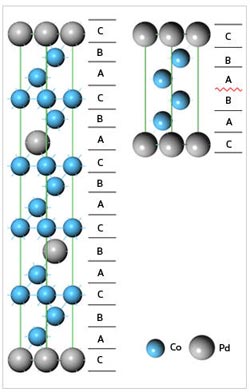Magnetic materials: Forging ahead with a back-to-basics approach

The atoms in a crystalline material known as Co4Pd1 are arranged into stacked layers labeled A, B and C (left). A single ‘mistake’ in this arrangement (right) can affect the material’s properties.<br><br>Modified, with permission, from Ref. 1 © 2012 EPLA<br>
Scientists have recently started to explore the possibility of using an intrinsic property of the electron known as spin for processing and storing information. Magnetic fields can influence the dynamics of electron spin, so harnessing this potential relies on precision engineering of crystalline storage materials.
Chee Kwan Gan and co©workers at the A*STAR Institute of High Performance Computing and the A*STAR Data Storage Institute in Singapore have used theoretical calculations to show how the magnetic characteristics of specific materials can be controlled at the atomic level1. Their results could lead to novel magnetic recording devices.
One promising route to such spintronic devices is to design structures consisting of alternating layers of different magnetic atoms. The strength of the magnetic influence is stronger in the direction of the multilayer stack than it is parallel to the planes of the atoms. This so-called perpendicular magnetic anisotropy is useful for spintronic memory devices because it allows a greater storage density than a conventional electronic device.
The properties of these structures, however, are highly sensitive to the precise arrangement of the crystal. Just one misplaced layer of atoms ¡ª a stacking fault ¡ª can noticeably alter device performance (see image). Previous studies usually ignored these special defects, ¡°but nature sometimes makes ¡®mistakes¡¯,¡± explains Gan. ¡°It is important to understand these defects and subsequently use them to control the material¡¯s physical properties.¡±
Gan and his team went back to basics to better understand how atom-level imperfections affect the properties of these multilayers. They used a powerful mathematical approach known as density functional theory. This approach uses only fundamental equations from quantum mechanics to model the behavior of electrons in these structures, without requiring any prior assumptions.
The researchers modeled a material consisting of alternating layers of cobalt and palladium atoms. Multilayers of these atoms have previously exhibited a large perpendicular magnetic anisotropy when the cobalt layers are less than 0.8 nanometers thick. Gan and co-workers then assessed how stacking faults and the ratio of cobalt to palladium atoms affected this anisotropy. Their results showed that a stacking fault could enhance the magnetic anisotropy in structures with a relatively thick cobalt layer. They also found that the anisotropy increased almost linearly with increasing cobalt content.
High magnetic anisotropy materials have potential for use in the next generation of ultrafast and high-capacity magnetic random-access memory, Gan explains. The improved understanding of these materials from this research will guide the way to realizing such devices.
The A*STAR-affiliated researchers contributing to this research are from the Institute of High Performance Computing and the Data Storage Institute
Journal information
Wu, G., Khoo, K. H., Jhon, M. H., Meng, H., Lua, S. Y. H. et al. First-principles calculations of the magnetic anisotropic constants of Co¨CPd multilayers: Effect of stacking faults. Europhysics Letters 99, 17001 (2012).
Media Contact
All latest news from the category: Materials Sciences
Materials management deals with the research, development, manufacturing and processing of raw and industrial materials. Key aspects here are biological and medical issues, which play an increasingly important role in this field.
innovations-report offers in-depth articles related to the development and application of materials and the structure and properties of new materials.
Newest articles

Properties of new materials for microchips
… can now be measured well. Reseachers of Delft University of Technology demonstrated measuring performance properties of ultrathin silicon membranes. Making ever smaller and more powerful chips requires new ultrathin…

Floating solar’s potential
… to support sustainable development by addressing climate, water, and energy goals holistically. A new study published this week in Nature Energy raises the potential for floating solar photovoltaics (FPV)…

Skyrmions move at record speeds
… a step towards the computing of the future. An international research team led by scientists from the CNRS1 has discovered that the magnetic nanobubbles2 known as skyrmions can be…





















